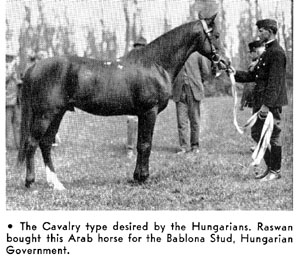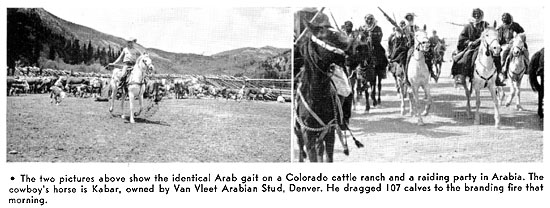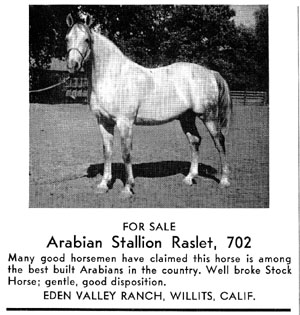| BENNIGSEN WROTE, the southern and western clans
of the Turcomans bred the finest horses. They were a handsome racing type,
tall, long necked, long croup, but well proportioned and with plenty of
bone, fire and endurance. He said the Tekeh clan owned the best of this
kind and that their quality came from the Arab bred to native Persian and
Tartar mares. Nadir Shah, the ruler of the country, continually improved
this breed with importations from Nejd (Central Arabia). He stated that
Turcoman horses not regularly improved with new infusions of Arabian blood
were high legged, narrower in chest, not barreled out enough in the ribs
and their pasterns were too long and their heads ugly.
SHAYKH Muhammad' Abd Ar-Rahman At-Tay, whom
I visited last in 1928 in northern Mesopotamia told me that his MUNIQI
HADRUJ, racing type Arabians, came from a cross with
a stallion that one of his forefathers brought from Asterabad by way of
Bushire, Persian Gulf, Basra. A Turcoman on his pilgrimage to the Holy
City had visited his tribe and became an inseparable friend of the old
Sheykh. Returning to the Caspian Sea the Turcoman persuaded his Bedouin
friend to join him and they left with a number of slaves, gazelle hounds,
falcons and Arabian horses. Two years later the Tayi chieftain returned
with his entourage and brought a number of Turcoman horses, among them
a splendid sire that was bred to a MUNIQIYAH mare.
IT MUST be remembered that the Tayi remained
in the middle of the Arabian desert until the 17th century when they moved
north to Iraq, on the border of southeastern Turkey. At that time thy were
famous for their pure-in-the-strain horses but not any more today.
I WOULD advise to read the descriptions by old
travelers Ker-Porter, Frazer, kinneir, Generals Malcolm and Bennigsen,
Muravive, Jourdain, Morier, Elphinstone who I remember gave much information
on horse breeding in Persia, Turkey and Asiatic Russia. Malcolm and Elphinstone
say (I have not their books but I quote from notes I took twenty-five years
ago [This would be about 1917] that Turcoman horses
more than any other oriental or eastern horses, resemble the English race
horse for size, 15 to 16 hands, long bodied, strong limbed, with excellent
temperament, very courageous and of unbelievable endurance. They often
covered 80 miles every day for two weeks or more on their raiding expeditions.
Without dismounting, Turcomans ride their horses 40 miles at a canter,
Frazer says, and they cover the distance form Bukhara to Teheran, almost
five hundred miles, in six days period.
I CAN testify to a similar feat of endurance.
When I went from Arabia to Persia in 1936 I stayed in Teheran where I met
a Turcoman chief who had arrived from Samarkand on horseback n eleven days,
a distance equal to that from New York to Miami or San Diego to Seattle.
The horse which I saw in a blacksmith shop of the Bazaar was lean as a
greyhound, about 15.2, a dark chestnut mare with a blaze and two white
hind feet. Head rather long, eyes big but set high, jowls large and wide,
profile line of face straight but the forehead was wide. Her neck was long,
shoulder, hind quarters, forearm, cannon bone were models of perfection
but the back was somewhat long, hind legs straight and perfect, good hocks
and knees, pasterns long but strong, good tall withers with croup slanting,
tail set high and carried high. This Turcoman mare showed the strain of
her long hard journey but she was ridden every day while in Teheran until
her master left for his tribe a thousand miles away.
THERE WERE many Turcoman horses in Persia. The
mounted police and cavalry rode them as did the wealthy village chiefs
owning horses that could be taken for tall but purebred Arabians of the
JILFAN, ABU URQUB
and MUNIQI strains.
THE FINEST of these animals were not less than
$750.00, some as much as $2000 while ordinary Turcomans sold for $150.
These figures are Frazer's which correspond with horse prices in Arabia,
Syria and Iraq.
BEFORE I close my remarks about Turcoman horses
I want to draw attention to some of the ancient writers who mentioned the
horses of old Media, the land which bordered on the Southern Caspian Sea
from Persia to Turkmenia. Aelian, living two thousand years ago, describes
the horses of Media as tall and beautiful, of proud bearing and graceful.
I refer also to Diodor, Strabo and Arrian, who should be read by horse
lovers. Alexander the Great on his second journey through Media found sixty-thousand
horses there, according to Arrian and Diodor.
THE HORSES of Nisaea are described by Oppian
in the second century; "excelling in beauty all other horses is
the horse of Nisaea," and then he goes on to say they are gentle
and obedient to the rein, have small heads and FLAXEN MANES
(honey-yellow). Favorinus mentioned the Gilvus (golden-yellow) color of
their manes. In fact his descriptions of the Nisaean horse fits the Isabelle
horse of Spain, the light-golden-reddish horse with flaxen mane and tail.
Philostratus and Herdot speak also of these Palominos of Persia and Palemon
whom General Bennigsen two thousand years later (1909) quotes on the honey
yellow color of the Nisaean horses and later calls "The Isabellen
horses of Nisaea as Palemon's steeds."
IT IS VERY possible the Spaniard took this word
Palomino from Palemon's book when he described the honey golden colored
horse of Persia. Most travelers in the 18th, 19th and 20th centuries who
left records of their journeys mentioned Palomino type horses in Persia
and Turkmenia. The horse called the Yellow Turk which was so famous in
the founding of the Thoroughbred breed in England also suggests the Palomino
color. He was probably a Turcoman.
MANY TURCOMAN horses are reported in early Thoroughbred
registrations, also in the Arab stud book in England. Merv, for example,
not an Arabian but as stated, a Turcoman horse brought to England by General
Baker. Also Nubian horses and others from the Sahara were registered, some
even brought in as Arabs by the Blunts before they went to Arabia and recognized
the true strains.
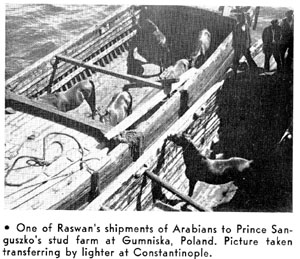
I WILL FINISH this article with a few notes
and corrections which should be checked by all Arabian breeders in America
and England.
MESHURA, MUNIQUIYAH mare
imported in 1881 was not purchased from the famous Ali Pasha Sherif of
Egypt, but from a Turkish official called Ali Pasha at Deyr on the Euphrates
River.
ARABIANS WHICH the Blunts themselves or their
friends imported were mostly of the classic type. I have checked and analyzed
many thousands of Arabian pedigrees and among them also the Blunt horses.
Here is what I found out and it should prove a most important discovery.
OF THIRTY-NINE imported Arabian stallions and
brood mares twenty-four were pure-in-the-strain: Jerboa, Pharoa's(sic)
dam, Saoud, Dajania, Hagar, Abeyan, Furshan's dam (imp. 1911), Kuhilet
El Krush (imp. 1927), Perghi's mare, Saadun, Sahub (sic), Saade, Horra,
Bozra, Meshura's dam, Dafina, Kars, Damask Rose, Burning Bush, Purple Stock,
Darley, Azz, Wazir, Bint Nura.
FRIENDS OF the Blunts imported the following
seven which were all pure-in-the-strain: Yataghan, Haidee, Zulielika, Joktan,
Ishmael, Kesia, Nimr (1914), and eleven other of the Blunt horses were
pure-in-the-strain too: Mabrouka, Feyda, Aida (I), Ghalaya, Bint Roda,
Ibn Nura, Gahrran, Ibn Mesaoud, Jemla, Meroe, Bushra. This covers practically
the greatest part of the Blunt foundation stock. To these we may add seven
more pure-in-the-strain horses in Ali Pasha Sherif and Blunt pedigrees:
Hamasa, Aziza (I), Jamilel Ahmar, Mahrousa, Bint Durra, Jemla, Nasr (I),
Ibn Bint Izz.
THE REST of the Ali Pasha Sherif horses, including
those which Blunts acquired at the famous auction sale March 26, 1897 in
Cairo were every one of the KUHAYLAN-SAQLAWI
and related strains not a single one being of MUNIQI
or their related strains.
IT SEEMS unbelievable but it is true and here
are the names: Abu Khasheb, Mahruss, Bint Helwa, Fulana, Jellabieh (1897
sale), Johara, Kasida, Makbula, Feysul, Badia, Shahwan, Sobha, Merzuk,
Mesaoud, Azz (Izz). Forty-nine pure-in-the-strain horses and fifteen of
the related strains. Even the few imported MUNIQIYAT were of pure strain.
Ads from the same issue:
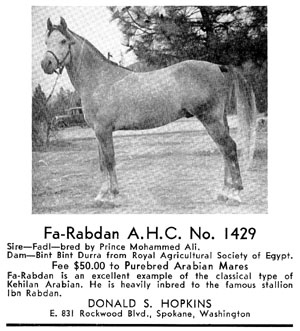
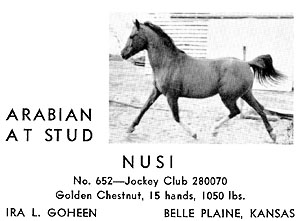
Contents
Page
|

